|
|
|
Sort Order |
|
|
|
Items / Page
|
|
|
|
|
|
|
| Srl | Item |
| 1 |
ID:
080567
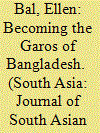

|
|
|
|
|
| Publication |
2007.
|
| Summary/Abstract |
This paper focuses on the relation between state policies and ethnicisation in the borderland of Bengal. On the basis of a case study of the lowland Garos of Bangladesh, the paper argues that attempts by the successor states of Bengal, East Pakistan and Bangladesh to 'other', and even 'exclude', the Garos have significantly impacted on Garo self-perception and organisation, resulting in the formation of a close-knit ethnic community. The paper focuses on three twentieth-century episodes in the lives of the lowland Garos. The first is the 1936 British administrative reorganisation of Mymensingh District which resulted in the emergence of a notion of a separate Garo homeland in Bengal. The second is the mass exodus of Garos across the international border into the Indian hills which took place in 1964. This traumatic experience pushed the Garos to unify. The third is the Independence War of 1971 and the birth of Bangladesh. All three episodes are directly related to state policies which excluded the Garos (as well as the neighbouring minorities) from the dominant discourse of Bengali/Bangladeshi citizenship. The paper concludes that the Garos of Bangladesh are a close-knit ethnic community - not in spite of these state attitudes - but rather as an outcome of them
|
|
|
|
|
|
|
|
|
|
|
|
|
|
|
|
| 2 |
ID:
080565
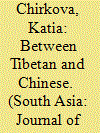

|
|
|
|
|
| Publication |
2007.
|
| Summary/Abstract |
This paper focuses on the ongoing process of changing local ethnic identities in the Southwest of China. The analysis is based on a comparison of two ethnic groups: Xumi and Baimi, both officially classified as Tibetans. While the experienced ethnic identity of the Xumi is in conformity with their official classification, the Baimi feel their own identity as being distinct from the classification imposed by the state. The related changes in local identities are examined with special emphasis on the role played by the Xumi and Baimi languages in creating and assessing group identity. I conclude that for both groups, albeit for various reasons, language is neither the major constructive element of ethnic boundaries nor an exclusive marker of ethnicity, which confirms Haarmaan's 1986 postulation that language is not a necessary criterion of ethnicity.
|
|
|
|
|
|
|
|
|
|
|
|
|
|
|
|
| 3 |
ID:
080564


|
|
|
|
|
| Publication |
2007.
|
| Summary/Abstract |
The peoples of north-eastern India often construct migration stories in an attempt to explain their history and present distribution. These stories assume that language and ethnic (tribal) boundaries coincide, and that they endure through long periods. Ethnic boundaries, however, are widely contested in north-eastern India, and even language boundaries are interpreted in varied ways so as to support particular ethnic and political goals. While people certainly migrate, they rarely do so as coherent tribes, and the present distribution of ethnic groups is better seen as an adjustment to environmental, economic, and political conditions than as the outcome of migrations. In the past, ethnic differences were constructed, and ethnic loyalty invoked, both to justify aggression and to rally defence against aggressors. Ethnicity is still used today, both to assert local differences and in an attempt to forge unity. Ethnic sentiments have contributed to the simmering violence that has punctuated the history of north-eastern India since the end of the colonial period.
1 This paper grows from my long interest in north-eastern India, an interest that goes all the way back to the 1950s when I made my first trip to the Garo Hills. My attitude toward migration theories was formed during innumerable conversations with Garos and other north-easterners, starting with that early trip and continuing later in both north-eastern India and in nearby districts of Bangladesh. For this paper, I am much indebted to my friend and one-time colleague, Ruata Rengsi of the History Department at North-eastern Hill University in Shillong, Meghalaya. Among other things, he has done his best to straighten out my understanding of ethnic and linguistic relations among the Mizo-Lakher-Kuki-Chin. I am also much in debt to Bettina Zeisler, Mark Post, and Stuart Blackburn with each of whom I have had extended conversations, some face-to-face but most by e-mail, about the ideas offered here. None of these will agree with all I have said in this paper, so please do not blame them because I am too stubborn to yield to all their arguments.
|
|
|
|
|
|
|
|
|
|
|
|
|
|
|
|
| 4 |
ID:
080563


|
|
|
| 5 |
ID:
080566
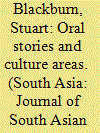

|
|
|
|
|
| Publication |
2007.
|
| Summary/Abstract |
This essay explores the possibility of defining a culture area by the comparative study of oral stories. Although neither the culture area concept nor the comparative study of oral traditions is currently fashionable in anthropology or folklore studies, both were once at the centre of theoretical debates in these disciplines. At the least, the hypothesis in this paper is intended to draw attention to the explanatory potential of both this concept and this methodology.
The data presented in the essay comes both from the author's fieldwork on oral stories and rituals in Arunachal Pradesh, India, and from similar collections made in neighbouring regions. Based on this evidence (primarily three separate oral stories and one ritual event), the essay suggests that we can consider the 'extended eastern Himalayas' as a culture area. This proposed culture area consists of three regions: central Arunachal Pradesh, the Myanmar (Burma)/India/Bangladesh border, and upland Southeast Asia/Southwest China. Adapting the model of vertical descent from historical linguistics, the argument is that the shared stories derive from a common oral tradition among Tibeto-Burman speakers. Horizontal borrowing across populations is not ruled out, but this model is usually best suited to explain commonalities in material culture. For similarities in verbal culture, such as the common oral stories in the extended eastern Himalayas, vertical borrowing down generations is a more convincing explanation
|
|
|
|
|
|
|
|
|
|
|
|
|
|
|
|
| 6 |
ID:
080584
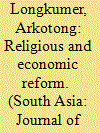

|
|
|
|
|
| Publication |
2007.
|
| Summary/Abstract |
The Heraka or Gaidinliu Movement among the Zeme Nagas of the North Cachar Hills, Assam, provides a case of millenarian activities based on agrarian reforms. The movement is associated with opposing British rule during the 1930s until India's Independence in 1947 under the guidance of Jadonang and later Gaidinliu. I examine the genesis of the movement which was based on agrarian reform by linking it with the influx of Kuki people and the effect of British land policy on Zeme agricultural practices which caused land shortages and famine. I argue that the Heraka Movement provided an alternative by abolishing certain rituals associated with the agricultural cycle and this in turn changed the social hierarchies and the worldview of the Zeme.
1 This paper was first presented at the 2006 European Conference of Modern South Asian Studies, organised by the European Association for South Asian Studies (EASAS) at Leiden University (Panel 28: Ethnicity and Development: Tribes and Small Peoples of India). I am grateful to Tahulung and Adeule for helping me understand the 'Zeme world'. I am thankful to Paul Streumer, Mohan Gautam, Lindsay Graham, Jeanne Openshaw, Amanda Bowden, Mark Turin, Steven Sutcliffe, Vibha Joshi and Erik de Maaker for their comments and feedback
|
|
|
|
|
|
|
|
|
|
|
|
|
|
|
|
| 7 |
ID:
080583
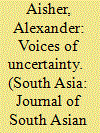

|
|
|
|
|
| Publication |
2007.
|
| Summary/Abstract |
Large-scale deforestation in the upper catchments of the Brahmaputra River represents a key anthropogenic factor at work in the landslides and floods that regularly impact upon Northeast India. For this reason, the conservation of forests in Arunachal Pradesh is of regional significance. Based upon fieldwork conducted with clans of the Nyishi tribe inhabiting the remote uplands of Arunachal Pradesh in 2002-2003, this paper argues that 'spirits', or uyu, are at the heart of local perceptions of forests. Drawing upon recent ecological models that stress the centrality of uncertainty, indeterminacy and surprise to the modelling of ecological dynamics, and the need to be sensitive to the interaction of structural features of human agency across a range of scales, this paper argues that the character and activity of such spirits not only reflect the susceptibility of the landscape to human disturbance, but also the uncertainties underpinning human economic interactions with a fragile and capricious mountain ecosystem. Through spirits, the human extraction of forest-related resources during hunting and shifting cultivation manifests as forms of exchange between humans and spirits. From within this cosmology, the rapid depopulation of many villages in upland Arunachal Pradesh in the present day, and the regeneration of forests around such villages, manifest as an increase of spirit-wealth. The paper concludes that in upland Arunachal Pradesh attention to 'spirits', or uyu, may indeed serve to foreground uncertainty, indeterminacy, surprise and other key ecological dynamics.
This paper is based on doctoral research carried out in Arunachal Pradesh in 2002-2003. This, the first detailed ethnographic study of Nyishi communities inhabiting the remote upland district of Kurung Kumey, was made possible through the guidance, assistance and support of many people within the Nyishi tribe
|
|
|
|
|
|
|
|
|
|
|
|
|
|
|
|
|
|
|
|
|